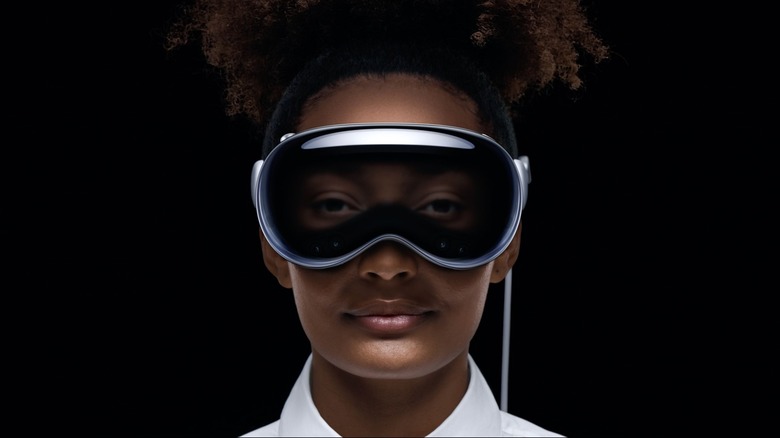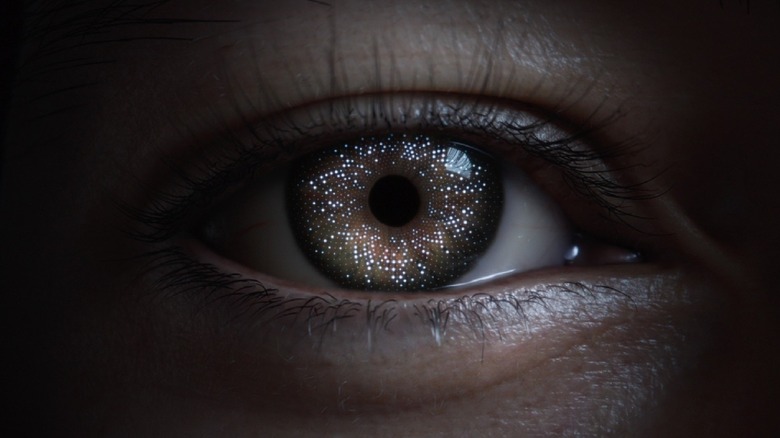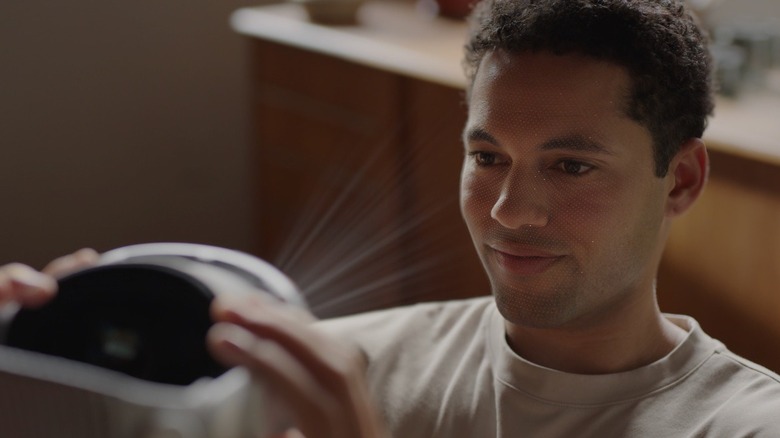EyeSight Is One Of Apple Vision Pro's Wildest Features
If you look at pictures of someone using Apple's upcoming AR headset, the Vision Pro, one thing will jump right out at you. You can see the user's eyes, and a shaded version of their face, through the headset itself. The headset isn't see-through, and even if it was the screens, lenses, and other components would still get between you and the person using it. Instead, this bit of face is scanned by little cameras inside the headset and relayed to a screen on the front. Apple calls this feature "Eyesight," and it's one of the modes that trigger automatically when another person is detected within the headset's range.
You'll see that person clearly due to the cameras on the outside of the HMD, and they'll be able to see a representation of the part of your face the headset obscures. From what we've seen so far, the image is absolutely perfect and makes it look like the person is wearing a set of ski goggles and not a VR headset. It should also be animated, and react to what the person wearing the headset is doing underneath it. Apple says this will help show people you're focusing on them, as eye contact tends to do, and make conversations feel more natural when one person is using the headset. However, while it's very realistic, there is a chance that it's just off enough to make people uncomfortable. Instead of making everything feel natural, this feature may make the headset take a running jump right into the "Uncanny Valley." We'll find out early next year.
Even more eyeball-based features are included
Being able to look through the headset and into a real person's eyes isn't the only ocularly-centered feature the Vision Pro has. The user's eyes will also be used as a navigation tool, allowing them to select apps and move around the headset just by staring at things. While this is a neat feature, the advanced, iris-based, tech goes even further than that.
Vision Pro will use your eyeballs as a kind of ID, thanks to its "Optic ID" feature. This security measure is apparently capable of quickly scanning a user's eyeballs to make sure that they're the person who is supposed to be using the headset in question. It may also be used in place of something like Face ID while the headset is in use which means you won't have to worry about passwords if you're working in the headset itself. Iris patterns are a bit like fingerprints, each one is unique to each person, and as a result, they make a fantastic biometric verification method. They're also arguably more secure, as people don't leave a bunch of "iris prints" on the very device that is using biometric security methods. As with Face ID, the biometric data gathered to make Optic ID function will be protected with heavy layers of encryption — so you don't have to worry about copies of your eyeball scans appearing in the shadier areas of the internet.
You can Facetime in it too
Eyesight isn't the only face-scanning feature the new headset is packing. Users will be able to map out their own faces with the headset's front cameras and save this scan to their profile. Judging by what we saw at WWDC, this scanning process will involve holding the headset a few inches from your face and looking at the front of it. Once the scan is complete, that scan will be put to good use.
From what we know so far, it will be used to create a highly detailed, almost photorealistic, avatar of the user. This avatar will then be used for things like Facetime calls, which makes sense when you think about it. The people you're Facetiming with will appear on screens within the headset, while the headset user will appear as his or her realistic avatar, instead of the cartoonish avatars Meta users are stuck with or something similar. It is unknown if these avatars will have further applications, or if Apple intends on rolling out more social features as its AR platform expands. What we do know is, Meta has been working on similar photorealistic avatars for a while, it's just not known when we'll actually see them in the "Metaverse."
Some of the other features are not so unique
While the Vision Pro is definitely a cutting-edge piece of XR tech, not all of its features are unique. In fact, many of them appear on far cheaper headsets, like Meta's Quest 2 and Quest Pro. The ability to watch things on a huge screen has been a VR headset staple for years now, voice commands are nothing special, and as far as interacting with laptops goes — powering a headset with a PC and a cable predates standalone VR by a long way.
Still, plenty of things Apple "unveils" have been done before. That doesn't really matter. Apple is a company that has built its business and reputation on doing things a little later than everyone else but executing them far better. We believe Apple's staff when they talk about the accuracy of its headset's hand tracking, how its display is going to be beautiful, or how the headset's modular design and high-quality materials make it incredibly comfortable to wear. Throw a unique feature like "Eyesight" in amongst polished versions of XR staples, and you're probably left with a very functional, very expensive, very "Apple," product.



